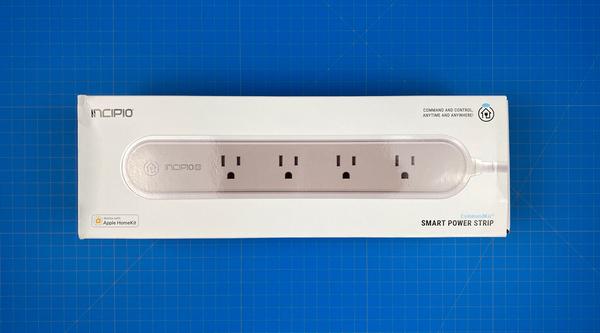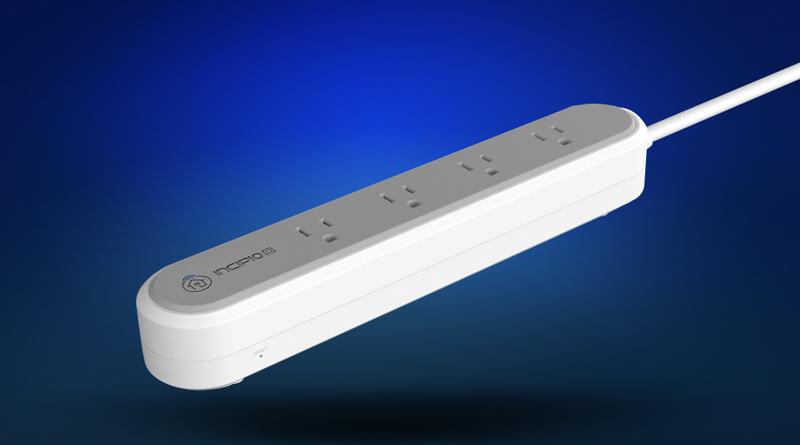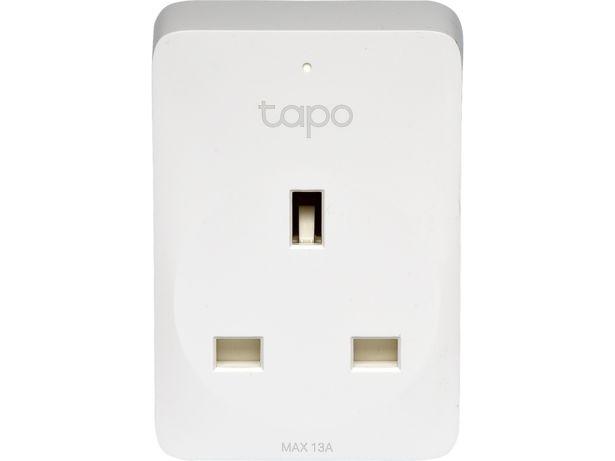Incipio Commandkit Smart Power Strip (review)
Incipio isn’t a name you might think of these days in relation to Apple HomeKit, but they were one of the first companies to release HomeKit-compatible devices, although it would seem – at least from the outside – that Incipio have thrown in the towel when it comes to HomeKit products, with no mention of any of the compatible device listed on their main site. Indeed, if you look carefully, right at the bottom of the Shop page of their website In the Smart Accessories list, you’ll see a subgroup called Smart Home Accessories, which basically leads to an empty page – not promising! Of course, they’ve long been making protective cases for phones and tablets, along with power supplies and cables, so don’t feel too sorry for them just yet.
I managed to pick up their Commandkit Smart Power Strip from Amazon recently, for the low, low price of US$16 – reduced from the usual RRP of around US$99, so it seemed like a bargain too good to pass up. In fact, as one colleague said, it’s even a decent price for a ‘dumb’ power strip, so why not? One should note that Incipio products in general, and this power strip in particular, have had very poor reviews and ratings (1.5 stars on amazon.com – ouch!), so was it even worth the US$16 + shipping? Read on to find out.
PACKAGING
The Power Strip arrived from Amazon in a rather large box, as the strip itself is also in a large box. Very big. Still, it’s nice to know it’s not going to get damaged easily, so no complaints in that area. The front of the packaging has the power strip with just the product itself on the front, flanked by the HomeKit logo and the name – CommandKit Smart Power Strip. All of Incipio’s HomeKit compatible devices seem to use the ‘CommandKit’ monicker, which confused me when I first started getting into HomeKit, as I wasn’t entirely sure if the company were trying to pass their devices off as HomeKit compatible with the ‘…Kit’ part. Note: it wasn’t as easy, even just a couple of years ago, to find out whether something was HomeKit compatible or not.
On the rear of the box, it’s more or less a list of features, all of which we’ve come to expect of many HomeKit devices, so in that respect, it’s nothing special although one feature isn’t seen as often, which is power metering. The rear of the box also has mention of the company’s own CommandKit HomeKit app. I wouldn’t bother downloading it though, as it has clearly been unattended for a while now, which you can see when you open it, as doesn’t support iPhone X size screens. In fact, whilst it’s supposedly a full third-party HomeKit app, half of the devices in my home didn’t appear in the app at all for some odd reason, so I didn’t waste a lot of time with it. The energy metering aspect of the strip is actually exposed to other HomeKit apps, so their app really isn’t of much use.
Given the size of the box, it’s good to see the device held properly in place with a cardboard section. Other than the device itself, there’s a small piece of paper explaining the basic parts of the strip on one side, with the other a quick start guide, including the HomeKit Code, which is the 8-digit variety, without QR code.
THE DEVICE
As far as I know, this is only one of two smart power strips with four outlets that work with HomeKit (the other being the recently reviewed Vocolinc VP2 for Europe), and the only one suitable for North American style (Type A) plugs, so although at full cost this was reaching the price of the Eve Power Strip, it does have the extra outlet. Unlike some of the competition, like the Koogeek 01US and the Vocolinc PM2/2E, this strip has no handy USB ports for charging iPhones or iPads, but that’s of less importance to me, as it allows me to use the fourth outlet for either a multi-USB port charger, or a regular plug, so I view it as more adaptable essentially.
Other than the outlets, it’s rather plain and ‘chunky’, with a slightly off-white body, topped off in grey where the outlets are, which is handy in a way, as scuff marks left by plugs on white plastic become hard to remove and that’ll do a good job of hiding them! At one end there’s a symbol to indicate when it’s searching for a wifi connection. If it is connected, then you’ll see no lights at all. When you initially set it up, it should briefly flash blue until it’s connected.
On the side, you have a small pinhole that’s used for resetting the device to its default/factory settings. The other side has four rather large, individual buttons, to manually turn each outlet on or off. We’ll come back to those shortly.

The plug that provides power to the strip itself is something you don’t see nearly often enough, in my opinion, which is that the plug is at 90º to the cable, thereby giving you a plug that can easily sit in a wall, with a chair or sofa, pushed quite close to it without any issues. The cable is also at roughly a 45º angle to the pins, so that the cable naturally hangs down, without undue pressure coming to bear on the cable itself. These are all well thought out little details, which do a little to counteract the device’s bad reputation, although no amount of good ergonomics is any use if a device doesn’t do what it’s designed to do of course.
The base of the Strip is, as expected, unremarkable save for one strange little cover. This cover comes off to reveal a rather standard red LED reset rocker switch. I’m going to assume this is to get power back to the device in the event of it turning off due to a power surge, although there’s no mention of it at all in the card that came with the strip. Other than this, there are four holes where screws reside to hold the strip together, although unlike some strips I have, this didn’t come with any rubber feet, to stop it sliding around. I did buy this for next to nothing though, and when I did unpack it, there were a few clues to indicate this was a returned product, as there were a few surface marks. Other than that, and the missing feet (if there were ever any, to begin with), it all looked rather nice. The box had a VERY strange odour though…
Going back briefly to the physical buttons, each of them has a green LED built-in, so you’re able to tell whether the outlet is on or off. Given that there are four of these rather large buttons, it’s safe to say that when they’re on the LEDs are rather distracting. I’d even go as far to say that they’d keep you up at night if you’re sensitive to lights when you sleep. It might have been better to have smaller buttons, with a small LED next to each outlet, rather than have them built into the buttons, but I’m sure it seemed like a good idea at the time. As you might also expect, turning the outlets on and off results in, what some people would describe, as quite loud. It really has no effect on my in all honesty, although if you were using this in a baby’s room, it could be an issue I guess.
Technical specifications;
INITIAL SETUP
As I don’t recommend you waste any time on the Incipio app as such, adding the device to the Home app is about as simple as it gets – Add Accessory > Scan code > name device > add to room etc., so very straightforward. As we’re into iOS13 territory now, any device that has more than one ‘service’ gets bundled into one tile by default, although much to everyone’s relief, Apple took onboard what a ridiculous idea this was and decided to offer people the option to split these services up. Perversely, in my case, I decided I’d prefer them to be under one tile, as the devices that are plugged into it (PS4, Apple TV, Blu Ray Player and a Smart camera) are on for most of the time, so I didn’t feel the need to have four separate tiles in the Home app staring back at me all the time, wondering when I’d press them.
I did refer briefly to the device having power metering functionality, and these details are also exposed to other HomeKit apps (not the Home app of course…). The details seem to refer to the combined power usage of all outlets, so unsurprisingly, there isn’t metering for individual outlets as such. This, I’m told is an expensive thing to add, and even with the Eve power strip it’s the same deal, with combined output for all four outlets, so I can’t take away anything from the Incipio model in this regard. Whether I find it of any use for such data is another thing of course.
IN DAY-TO-DAY USE
It’s fair to say I’ve not heard much that is positive about Incipio, at least when it comes to their HomeKit devices. From my own perspective, before this power strip, I only had one other device by the company, namely the CommandKit Smart Socket (you can read my review here). This has been really reliable in the two years I’ve had it, and so on reading all the reviews on Amazon stating how poor this device was in terms of connectivity, I didn’t hold out much hope, but at $16 I wasn’t going to worry too much about it anyway. I’ve read through the reviews and the common theme is that the device disconnects after a few hours, and requires removing and re-adding. I don’t doubt these users’ experiences at all and have seen this kind of behaviour with other HomeKit devices, but after two months of testing this, in my case, I’ve only seen a couple of disconnections, which is odd, as I really was waiting for it to happen. Even with the current issues surrounding iOS13 and the Home app, I was expecting trouble, but I really haven’t had any real issue with it. That’s not to say it won’t happen in the next two months of course, but all the reviews mentioned disconnections within a couple of hours of setup. If I notice anything untoward in this respect, I’ll amend/update the review to reflect this.
There’s not a massive amount to be said about this device in truth, as in my case, it could easily be replaced with a dumb power strip for most purposes, but I couldn’t pass up the chance to try it out when the price plummeted. I’m actually glad I did though, as it is of some use to me. It certainly doesn’t look as cool as the Eve Power Strip, that’s evident, but at a fraction of the price right now, I can forgive its utilitarian looks.
All that said, it’s clear that Incipio has all but thrown in the towel for Smart Home products, so it’s hard for me to recommend this if you’re hoping for some after-sales support, as I doubt there will be any. All I can say is that if you see one going very cheap (someone recently bought seven of them at $4 apiece!) take a chance, and hopefully, you’ll get reliability out of it.



